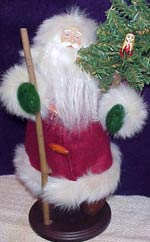  Russia Russia 
 In the days of the Soviet Union, Christmas was not celebrated very much.
New Year was the important time - when 'Father Frost' brought presents
to children. With the fall of Communism, Christmas can be openly
celebrated - either on December 25th; or more often on January 7th. This
unusual date is because the Russian Orthodox church uses the old
'Julian' calendar for religious celebration days.
In the days of the Soviet Union, Christmas was not celebrated very much.
New Year was the important time - when 'Father Frost' brought presents
to children. With the fall of Communism, Christmas can be openly
celebrated - either on December 25th; or more often on January 7th. This
unusual date is because the Russian Orthodox church uses the old
'Julian' calendar for religious celebration days.
St. Nicholas is especially popular in Russia.
The legend is that the 11th-century Prince Vladimir traveled to
Constantinople to be baptized, and returned with stories of miracles
performed by St. Nicholas of Myra. Since then many Eastern Orthodox
Churches have been named for the saint, and to this day, Nicholas is one
of the most common names for Russian boys.
The feast of St. Nicholas (December 6th) was
observed for many centuries, but after the communist revolution, the
celebration of the feast was suppressed. During the communist years St.
Nicholas was transformed into Grandfather Frost. Other religious
traditions were suppressed during the communist era. Before the
revolution, a figure called Babouschka would bring gifts for the
children. Like Italy's La Befana, the story is that Babouschka failed to
give food and shelter to the three wise men during their journey to
visit the Christ Child. According to tradition, she still roams the
countryside searching for the Christ Child and visiting the homes of
children during the Christmas season. Babouschka never completely
disappeared, and now in the post-communist era, has returned openly.
Christmas trees were also banned by the Communist regime, but people
continued to trim their "New Year's" trees.
Most Christian Russians belong to the Eastern
Orthodox Church, and it is customary to fast until after the first
church service on Christmas Eve. Christmas Eve dinner is meatless but
festive. The most important ingredient is a special porridge called
kutya. It is made of wheatberries or other grains which symbolize hope
and immortality, and honey and poppy seeds which ensure happiness,
success, and untroubled rest. A ceremony involving the blessing of the
home is frequently observed. A priest visits the home accompanied by
boys carrying vessels of holy water, and a little water is sprinkled in
each room. The kutya is eaten from a common dish to symbolize unity.
Christmas Index
Free
Christmas Wallpapers and Screensavers
 Let
Us Spread The Christmas Spirit Let
Us Spread The Christmas Spirit
|